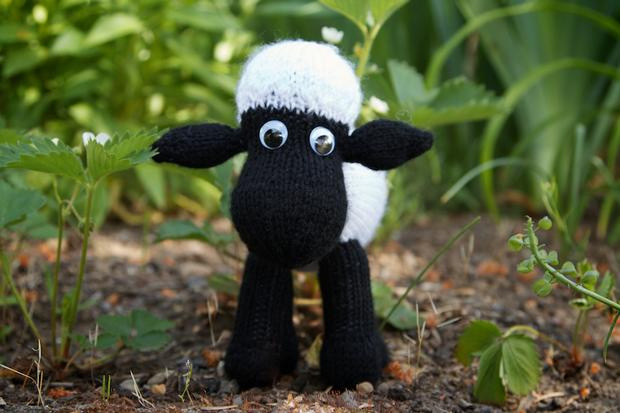There are lots of educational possibilities in yarn. (Yes, yarn!) Knitting is a marvelous activity for kids, touted by 18th-century educator Johann Pestalozzi for teaching math skills, routinely featured in the Waldorf school curriculum, and today popping up in public- and private-school classrooms, and countless homeschool living rooms.
See below for knitting how-tos, knitting stories, knitting with math and science, and some great books about sheep.
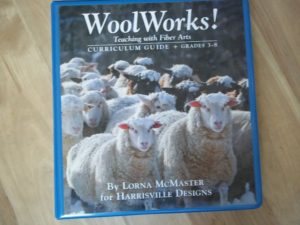
|
For starters, check out WoolWorks! by Lorna McMasters (Harrisville Designs, 2009). This is a beautifully done 12-lesson fiber arts curriculum guide for grades 3-8, packaged in a blue loose-leaf notebook (with photo of particularly woolly sheep on the cover), and illustrated throughout with color photographs and diagrams. Tucked in a pocket in the front is an illustrated “Sheep and Wool Map of the World,” with drawings of dozens of different breeds of sheep (among them the Hungarian Zackel, which has corkscrew horns, and the Scotch Blackface, which looks like a walking shag carpet). The lessons – which include in-depth historical and scientific background information, varied projects with complete instructions, and supplementary resource lists for teachers – variously cover the history of sheep, the science of wool, felting, spinning, natural dyeing, braiding, weaving, and knitting.For example, kids make felted pouches and juggling balls, produce different-colored yarns from a range of natural dyes, build a traditional Japanese “Maru Dai” or braiding stool (braids, it turns out, were used to lace plates of samurai armor together), experiment with paper weaving, potholder looms, popsicle-stick “backstrap” looms, and tapestry looms, and learn to knit. |
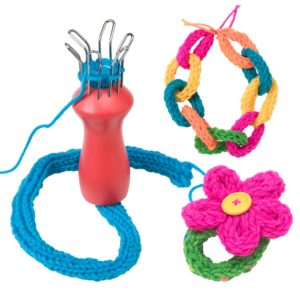
|
Our three boys began their (limited) knitting careers with a knitting mushroom, which somebody got for a birthday. The mushroom is a variation on the knitting spool or knitting nancy, a clever little doohickey with which kids can produce long knitted strings, suitable for making bracelets or headbands. (The strings can also be coiled and stitched; there was talk here once of making an entire dining-room rug, but we settled for a trio of coasters.) Knitting spools (etc.) are available in a range of permutations in wood and plastic. |
| See these You Tube instructions for making your own spool knitter, using a cardboard tube and craft sticks. | |
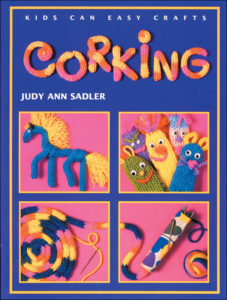 |
Judy Ann Sadler’s Corking (Kids Can Press, 1995) includes instructions for making your own home-style knitting spools from toilet-paper rolls and tin cans, along with knitting instructions and an assortment of simple projects for ages 5 and up. |
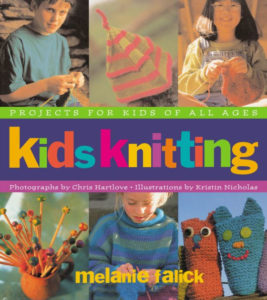
|
Melanie Falick’s Kids Knitting (Artisan, 2003), targeted at ages 5-12, is a 128-page guide illustrated with bright drawings and color photographs that takes young knitters from first stitches to first sweater. Projects are arranged in order of difficulty (starting with a simple square), and Falick also provides instructions for making your own wooden knitting needles, dyeing yarn (with Kool-Aid), felting, and more. |
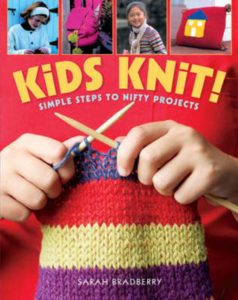 |
Also see Sarah Bradberry’s Kids Knit! (Sterling, 2006) for ages 8 and up, which features instructions for 20 kid-friendly knitting projects, among them a washcloth, a scarf, a teddy-bear puppet, and a tote bag. |
Arguably the most famous knitter in fiction is Madame Defarge, the sinister villain in Charles Dickens’s Tale of Two Cities, who sits clicking her needles at the foot of the guillotine – but there’s also the busily knitting Sheep encountered by Alice in Lewis Carroll’s Through the Looking-Glass, and Agatha Christie’s clever Miss Marple who adroitly solves murder mysteries while knitting.
Among the pleasantly funny stories in Robert McCloskey’s Homer Price (Puffin, 2005) is a tale of a knitting competition and some truly enormous balls of yarn; and in Eleanor Estes’s The Middle Moffat (Sandpiper, 2001), set in the days of World War I, young Jane struggles to knit a scarf (or maybe a helmet) for a soldier in France. Laura and Mary knit mittens and stockings in Laura Ingalls Wilder’s Little House books; and in Mary Norton’s The Borrowers, Homily – the tiny Borrower mother – knits sweaters made of cotton thread using straight pins as knitting needles.
All the troubles in Dr. Seuss’s environmental parable The Lorax (Random House, 1971) stem from knitting, when the greedy Once-ler discovers that the Lorax’s beloved Truffula trees can be turned into knitted thneeds. And who can forget the gaudy hand-knitted Weasley sweaters in Harry Potter?
Also see:
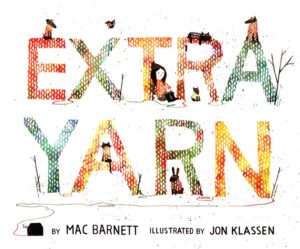
|
Mac Barnett’s Extra Yarn (Balzer + Bray, 2012) for ages 4-8 – with wonderful illustrations by Jon Klassen – is the story of Annabelle who “on a cold afternoon, in a cold little town, where everywhere you looked was either the white of snow or the black soot from chimneys,” found a marvelous colorful box of yarn. Soon, knitting sweater after sweater (for people, dogs, and even pickup trucks), she turns the town into a warm and brightly colored place – until a selfish archduke steals the mysterious and seemingly bottomless yarn box. But he gets his comeuppance. A thoroughly delightful read. |
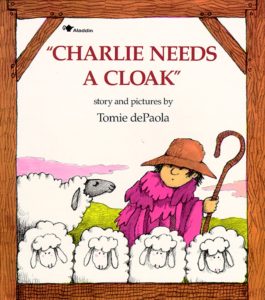
|
In Tomie dePaola’s Charlie Needs a Cloak (Aladdin, 1982), Charlie the shepherd needs a cloak – and the story shows how he goes about getting one, from shearing the sheep through washing the wool, spinning, weaving, dyeing, and sewing the new garment. The sheep help out (or not) every step of the way, and much of the charm of the story is in the clever and whimsical illustrations. For ages 4 and up. |
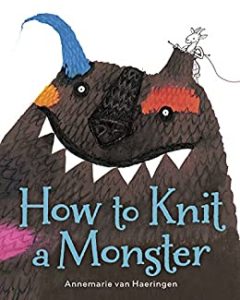 |
In Annemarie van Haeringen’s How to Knit a Monster (Clarion, 2018), Greta the goat is such a talented knitter that her creations can come to life – but if she doesn’t pay attention, suddenly monsters spring from her needles and she needs to knit her way out of danger. For ages 4-7. |
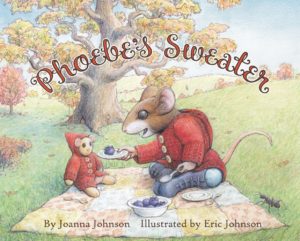
|
Joanna Johnson’s Phoebe’s Sweater(Slate Falls Press, 2010) is the story of a young mouse whose mother is expecting a baby. While waiting for Phoebe’s new brother or sister to be born, the mother knits Phoebe a very special sweater. Included in the book are knitting patterns for Phoebe’s sweater and a Phoebe mouse toy. For ages 4-8, plus an adult knitter. |
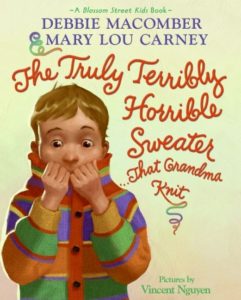
|
Sweaters, of course, aren’t always a success. In The Truly Terribly Horrible Sweater That Grandma Knit (HarperCollins, 2009) by Debbie Macomber and Mary Lou Carney, Cameron gets a handmade sweater from his grandmother for his birthday – and he hates it. He does his level best to get rid of it – dousing it with mustard, putting it on the dog – all to no avail. Then Grandma comes to visit and explains why she chose each of the sweater’s special colors, and Cameron comes to understand that when it comes to gifts, it’s the thought that counts. For ages 3-7. Included are knitting instructions and the pattern for the truly terrible horrible sweater. |
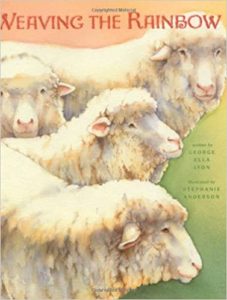
|
George Ella Lyon’s Weaving the Rainbow (Atheneum/Richard Jackson Books, 2004) for ages 3-8, illustrated with lovely soft watercolors, is the start-to-finish story of a weaver and her flock of sheep, showing how wool is transformed into a rainbow-colored woven tapestry. |
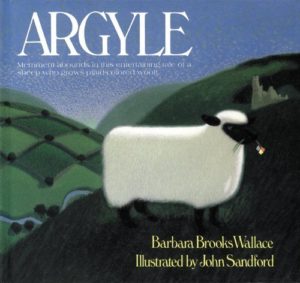
|
In Barbara Brooks Wallace’s Argyle (Boyds Mills Press, 2004), Argyle – an ordinary plain-white sheep – discovers a secret field of magical flowers and, after eating them, develops a coat of brilliant multi-colored stripes. The shepherd’s wife knits Argyle’s wool into spectacular plaid socks, which make her and her husband rich, and Argyle famous. Fame, unfortunately, isn’t much fun – and Argyle is relieved when the magic wears off and he’s able to return to his flock. For ages 5-9. |
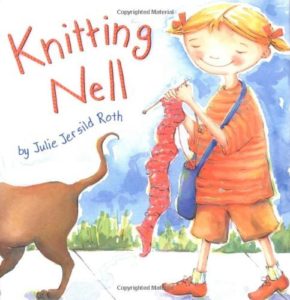
|
In Knitting Nell by Julie Jersild Roth (Houghton Mifflin, 2006), Nell – who was once told by mean Danny Tucker that she has a voice like a cricket with a pillow over its head – is shy and quiet and hardly ever talks. What she does, however, is knit – making blankets for new babies, and hats and socks and mittens for people in need. None of her friends think much of her hobby – until she knits a sweater that wins first prize at the county fair and receives a medal for her many good works for others. Clever artwork and design add greatly to the story. For ages 5-9. |
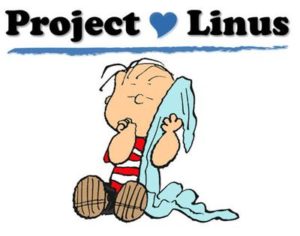 |
Donate a knitting project! The Snuggles Project recruits volunteers to knit security blankets for homeless animals. The Linus Project is an organization of volunteer “blanketeers” who knit blankets for sick or needy children.
Also see Knitting for Charity, which has a list of volunteer organizations and knitting patterns. |
